Weeping Cherry Trees: Types and Care (Including Dwarf Weeping Cherry Trees)
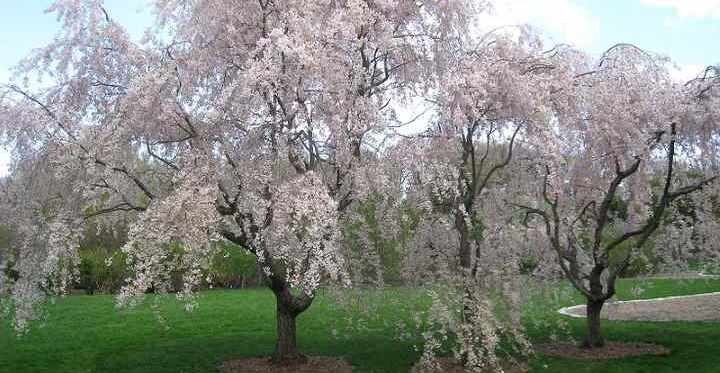
Weeping cherry trees are spectacular flowering trees, producing masses of beautiful pinkish-white flowers in spring on cascading branches. Although the blossoms on weeping cherry trees are short-lived, they turn garden landscapes into magnificent colors. Their pendulous, arching branches give the tree an eye-catching drooping, umbrella-like growth habit.
Weeping cherry trees range in size from dwarf weeping cherry trees at 8 ft. (2.4 m) tall to large weeping cherry blossom trees as tall as 40 ft. (12 m).
Weeping cherry trees add delightful shades of pink and white to gardens. However, caring for these ornamental blossom trees can be tricky. Weeping cherry trees grow best when planted in full sun and well-drained soil.
In this article, you’ll find out about some of the best weeping cherry trees and varieties of dwarf weeping cherry trees. You’ll also get some handy tips on how to grow these cherry blossom trees in your front or backyard.
What are Weeping Cherry Trees?
Weeping cherry trees are deciduous flowering trees in the genus Prunus. The cascading tree branches droop down low because they are relatively soft and limp. These flexible branches then “weep” under their weight. The “weeping” part of the cherry tree is grafted onto a cherry tree rootstock.
Weeping cherry trees grow best in USDA planting zones 4 through 8 when planted in full sun.
Weeping cherry trees produce fruit but it may be very small and considered inedible due to its sour taste. However, weeping cherry blossom trees are attractive to birds because they feed on the fruit.
Weeping cherry trees produce multitudes of white or pink flower clusters, with flowers each having at least five petals. These blossoms cover the weeping branches that almost touch the ground. Weeping cherry tree flowers can be white or pink and single or double flowers. The masses of beautiful flowers appear on the arching branches before the leaves on most cherry tree cultivars.
Many types of cherry blossom trees are also called sakura. Sakura is the Japanese word for cherry blossom, and some Japanese weeping cherry trees are simply called sakuras. One of the most popular weeping trees is the Prunus serrulata ‘Kiku-Shidare-Zakura,’ or Japanese Weeping Cherry.
Many weeping cherry blossom tree cultivars have year-long interest. Some types of trees have glossy green lanceolate leaves on cascading branches that provide shade in the summer. Their foliage turns a stunning orange, red, or gold in the fall.
How Big do Weeping Cherry Trees Get?
Weeping cherry trees grow to between 20 and 35 ft. (6 – 10.6 m) tall. Their huge canopy with arching, cascading branches can be as large as the tree is tall.
What is Dwarf Weeping Cherry Tree?
Dwarf weeping cherry trees are smaller cultivars of the standard weeping cherry trees. Dwarf weeping cherry blossom trees have a compact growth, making them ideal for small backyards or growing as a dwarf flowering specimen tree.
How Big do Dwarf Weeping Cherry Trees Get?
Dwarf weeping cherry trees grow between 6 and 10 ft. (1.8 – 3 m) tall. Miniature weeping cherry trees often have a slender look because their branches usually hang down vertically to the ground.
Varieties of Dwarf Weeping Cherry Trees
Here are a few varieties of dwarf weeping cherry trees that are suitable for most garden landscapes:
- Snow Fountain dwarf weeping cherry (Prunus serrulata ‘Snow Fountain’). This small cherry blossom tree has a strong weeping habit and it produces masses of fragrant flowers.
- Japanese flowering dwarf weeping cherry tree (Prunus ‘Kiku-Shidare-Zakura’). This spectacular sakura has showy, double pink flowers and gracefully drooping branches.
- Hiromi dwarf weeping cherry tree (Prunus jacquemontii ‘Hiromi’). This small weeping, compact tree bursts into pink when cherry blossoms emerge in spring.
How to Care for Weeping Cherry Trees
Grow weeping cherry trees in full sun where they get plenty of sunlight. It’s also vital to regularly water the cherry tree to keep the soil moist without being too soggy. To ensure healthy growth, plant the trees with enough space between the arching umbrella canopies to allow for plenty of air circulation.
Weeping Cherry Blossom Season
Weeping cherry trees produce flowers during spring. Cherry blossoms may only last for two to three weeks. Usually, weeping cherry trees with double blossoms last the longest. An early bloomer is the double weeping cherry tree Prunus pendula ‘Rosea.’ Other cherry tree cultivars may bloom later.
Types of Weeping Cherry Trees (With Pictures)
Let’s look in more detail at some breathtaking examples of weeping cherry trees that blossom in spring.
Weeping Higan Cherry (Prunus subhirtella ‘Pendula’)
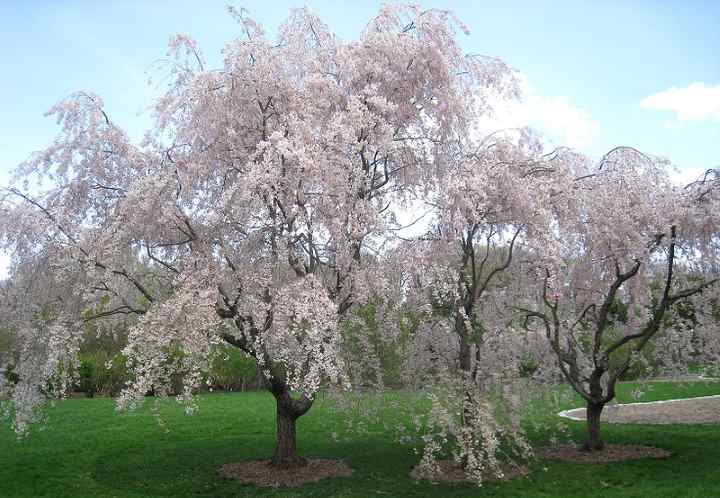
Weeping Higan cherry trees (Prunus subhirtella ‘Pendula’)
Weeping Higan cherry trees are tall flowering trees growing up to 30 ft. (9 m) high. Higan cherry blossom trees with their umbrella canopy produce clusters of double pinkish-white flowers when they blossom in spring. During summer, the drooping branches are covered with glossy green lance-shaped leaves. However, the Weeping Higan cherry doesn’t have spectacular fall foliage.
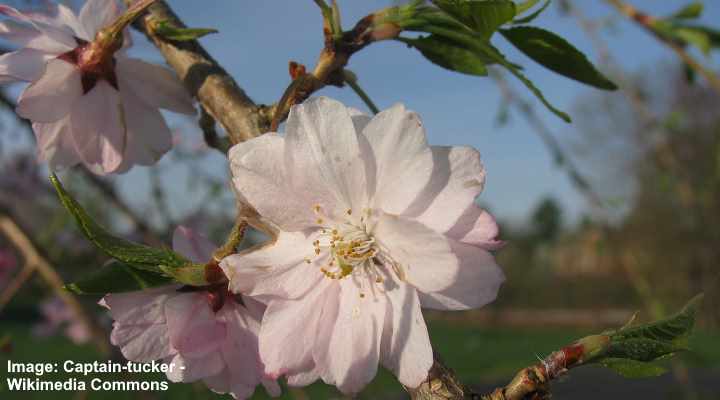
Weeping Higan cherry tree flowers
The drooping Higan cherry tree branches almost reach the ground. So, regular pruning is required to walk or sit under the tree in the shade.
The outstanding feature of Weeping Higan cherry trees is their showy white or light pink blooms.
Double Weeping Cherry (Prunus x subhirtella ‘Pendula Plena Rosea’)
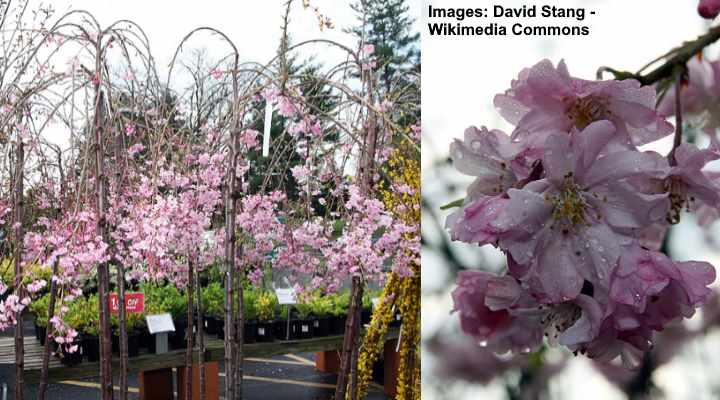
Double weeping cherry blossom is a pink weeping cherry tree (close-up picture of the tree and its flowers)
Double weeping cherry blossom (Prunus ‘Pendula Plena Rosea.) is a stunning fast growing tree that blossoms in mid-spring with double pink flowers. This pink pendulous cherry tree cultivar is one of the longest-blooming of all the weeping cherry tree cultivars.
The Double Weeping cherry tree grows between 15 and 25 ft. (4.5 – 7.6 m) tall with a spread of up to 25 ft. (7.6 m). It’s not just the branches of this Japanese cherry tree that have drooping growth. The spectacular pink flowers also dangle from branches in clusters of three or four blooms.
Weeping Yoshino Cherry (Prunus x yedoensis ‘Shidare-Yoshino’)
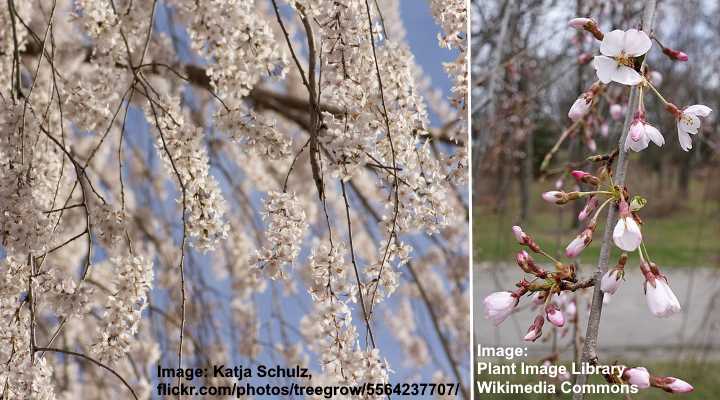
Weeping Yoshino cherry (Prunus x yedoensis ‘Shidare-Yoshino’)
The Japanese weeping Yoshino cherry tree has graceful weeping branches. This early-spring bloomer produces masses of white blossom clusters covering the dangling branches. After the white blossoms fall, dark green pointed lanceolate leaves create a summer canopy. These then turn a bronze and gold color before dropping in the fall.
The ‘Shidare-Yoshino’ cultivar grows to between 20 and 25 ft. (6 – 7.6 m) with a vast drooping canopy up to 30 ft. (9 m) wide. These weeping Japanese cherry trees grow in USDA zones 5 through 8 and enjoy full sun and moist soil.
Japanese Weeping Cherry (Prunus serrulata ‘Kiku-Shidare-Zakura’)
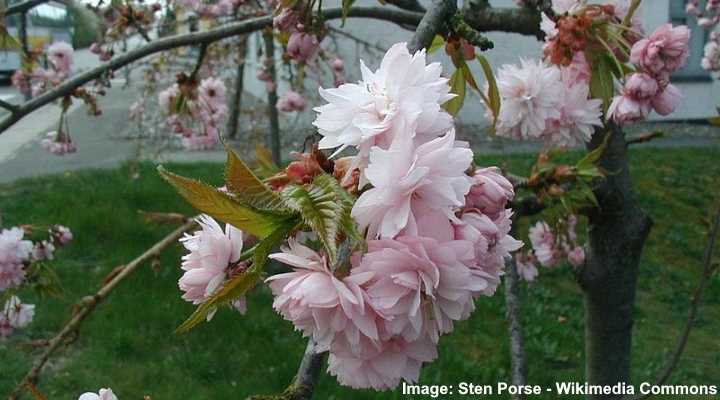
Japanese weeping cherry or Cheal’s Weeping Cherry Tree (Prunus serrulata ‘Kiku-Shidare-Zakura’) has pink flowers
Also called sakura or Cheal’s weeping cherry, the small deciduous Japanese weeping cherry trees have spectacular showy pink ruffled flowers. The large cherry tree flowers grow up to 1.5” (3.5 cm) across and have up to 125 petals. What makes these large blossoms even more eye-catching is that they grow in clusters of three to five flowers on bare drooping branches.
The best way to grow the Japanese weeping cherry tree is as a specimen tree in your front or backyard. Depending on pruning, you can grow the Japanese weeping cherry (Prunus ‘Kiku-Shidare-Zakura’) as a dwarf weeping cherry tree or small cherry tree cultivar. The cherry tree grows between 10 and 15 ft. (3 – 4.6 m) tall with a spread of up to 10 ft. (3 m)
Pink Snow Showers Weeping Cherry (Prunus x ‘Pisnshzam’ syn. Prunus ‘Pink Snow Showers’)
Pink Snow Showers weeping cherry trees are small landscaping flowering trees that blossom in spring. The cascading branches have masses of double pink or mauve flowers. The elegant drooping flowers and foliage make the Pink Snow Showers a prized variety of weeping cherry trees.
This weeping cherry tree’s eye-catching characteristics are its red bark that contrasts with the dark green leaves that turn golden yellow in the fall. This graceful weeping cherry tree grows up to 25 ft. (7.6 m) tall with a similar-sized spread.
Types of Dwarf Weeping Cherry Trees (With Pictures)
Many weeping cherry tree cultivars have a small compact growth, making them dwarf tree varieties. Let’s look at some stunning dwarf weeping cherry trees.
Snow Fountain Weeping Cherry Tree (Prunus serrulata ‘Snow Fountain’)

Snow Fountain weeping cherry tree (Prunus serrulata ‘Snow Fountain’)
The weeping Cherry Snow Fountain is a stunning example of a dwarf weeping cherry tree. Masses of fragrant white flowers blossom on hanging branches that reach the ground. The ‘Snow Fountain’ cherry tree blossoms in mid-spring before the dark green leaves appear. In fall, the lush foliage turns to spectacular hues of orange and golden-yellow colors.
This small weeping cherry tree is a slow-growing variety that grows between 8 and 15 ft. (2.4 – 4.5 m) tall. The branches hang almost vertically down, giving the cherry tree a narrow spread of only 8 ft. (2.4 m).
As with all cherry tree cultivars, it grows best in full sun and fertile, moist soil with excellent drainage. Any garden landscape with a ‘Snow Fountain’ cherry tree will look stunning.
Hiromi Weeping Cherry Tree (Prunus jacquemontii ‘Hiromi’)
Hiromi weeping cherry trees are the smallest type of weeping cherry tree. The large shrub-like cherry tree with drooping branches grows around 6 ft. (1.8 m) tall. The almost vertically hanging branches give the drooping tree a slender look with a spread of about 2 ft. (0.6 m)
Learn how to plant and care for dwarf weeping cherry trees.
How to Plant a Weeping Cherry Tree
Weeping cherry trees should be planted in spring before the buds and leaves appear. But some experts say that you can do this at any time of year if you’re transplanting an established tree. However, it’s vital to care well for the tree in the first few months to reduce root stress and ensure the tree is stable.
Weeping cherry trees grow best and bloom abundantly growing in a sunny location; however, some shade is also fine. The soil must have excellent drainage, and you have to keep it moist as weeping cherry trees don’t like dry conditions. Making sure there’s plenty of air circulation helps keep the tree healthy and free from disease.
Weeping cherry trees are sensitive, and you need to take care when transplanting them. To prepare the ground for planting, dig a hole that’s three times the root ball’s size but not deeper than it. The soil line on the trunk indicates the right depth for planting your weeping cherry tree.
With small and dwarf weeping trees, you should notice the graft bump near the base of the trunk. This should be 2” to 3” (5 – 7.5 cm) above the ground’s surface.
You’ll also need to stake the weeping cherry tree for the first year to allow the roots system to grow and support the tree.
When your tree is at the right height, fill the remaining space with soil that has perlite mixed in for extra drainage. It’s important to take measures not to damage the roots. Press the ground firmly down to remove any air pockets. Then thoroughly water the plant and put a 2” (5 cm) layer of mulch around the trunk, leaving about a 2” (5 cm) gap free around the trunk.
During the first two seasons, you will also need to water the tree regularly during dry spells to keep the plant growing well.
How to Prune Weeping Cherry Tree
It would be best if you only pruned weeping cherry trees in early spring or late fall. During this time, the tree’s growth is dormant, and you won’t stress it. So, you need to prune the weeping branches before flower buds appear or after the leaves have fallen.
To prune weeping cherry trees, you should only ever remove dead, decaying, or diseased branches. Weeping cherry trees are grown for their long, drooping branches. The only time to prune a tall weeping tree is to shorten the branches if you need to walk under it.
When pruning weeping cherry trees, use a sharp pair of sterilized pruning shears. Snip the dangling branches back, so they are about 6” (15 cm) from the ground.
Weeping Cherry Growing Tips
Extra care and attention are required to grow weeping cherry trees in your garden. The primary consideration for these drooping cherry trees is to grow them in full sun in soil that’s moist but never dry or waterlogged soggy.
However there are a few other things to remember when it comes to growing weeping cherry trees.
Weeping cherry trees grow best in loamy soil that has excellent drainage. In backyards weeping cherry trees prefer growing in acidic, fertile ground. If you have sandy soil, you should use compost to make the soil more acidic. You can also work in perlite, pumice, or crushed granite to increase drainage.
Weeping cherry trees can grow in containers. If you decide to do this, use an aerated potting mix with one part houseplant soil, one part peat moss, and one part perlite.
Weeping cherry trees need enough watering to keep the soil moist but never too soggy. You should water a weeping cherry tree once or twice a week in dry periods, giving the tree plenty of water so that it soaks down to the roots. However, always let the soil dry out between watering. Weeping cherry trees develop root rot if they grow in waterlogged soil.
During winter, it’s not necessary to water weeping cherry trees. Cherry tree growth becomes dormant, and they don’t need extra watering.
Weeping cherry trees benefit from fertilizing in early spring to encourage vibrant blossoms and vigorous growth. Slow-release fertilizers help provide plenty of nutrients throughout the growing season. The best fertilizer for weeping cherry blossom trees is compost.
To get your cherry tree ready to blossom in spring, spread plenty of compost under the canopy of the cascading branches. You can also add mulch to lock in moisture and provide more nutrients as it breaks down into the soil.
Weeping cherry trees grow suckers in spring that you need to remove. You may notice the new growth at the base of the trunk. You should remove them as soon as you see them. Also, check around the graft scar on the rootstock. Shoots can also grow from here and you should remove them immediately.
Related articles:
